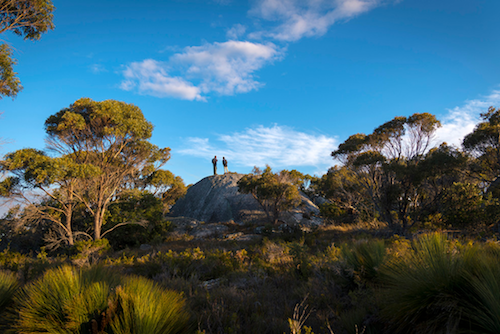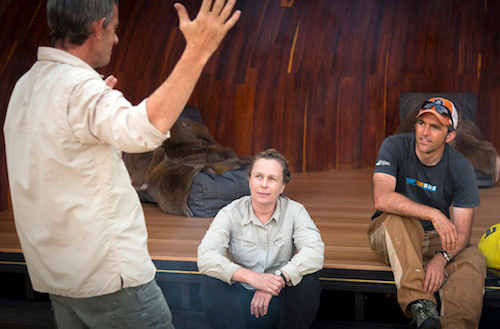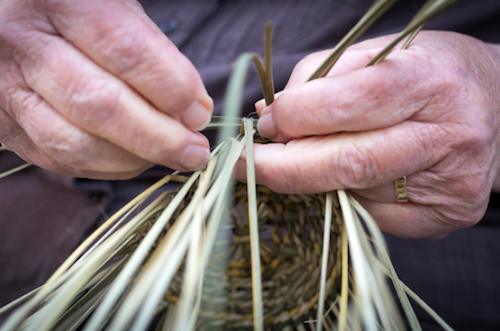Wukalina Walk – Cultural Homeland Of The Palawa
Words by Alice Hansen - Tailored Tasmania
Images by Rob Burnett
Some have walked the Tasmanian landscape for thousands of years. wukalina is Tasmania’s latest multi-day guided walk, an opportunity to experience the palawa (Tasmanian Aboriginal) culture across four days in the far North East. The palawa came to Tasmania some 40,000 years ago when a land bridge existed between mainland Australia and Tasmania. To walk with them is to understand the very beginnings of this island.
THE LOCALE
Heard of the Bay of Fires? Add cultural depth to the layers of vibrant orange lichen and lapping sapphire waters. It’s the first experience of its kind in Tasmania. The walk is based on the northern end of Tasmania’s East Coast, an area featuring larapuna/Eddystone Point, wukalina/Mount William and the alluring Bay of Fires. It is the homeland of the palawa. Stories untold are shared along the way, as Aboriginal elders follow the footsteps of their elders.
At significant sites such as middens, look out to the rolling waves and Tasman Sea beyond, a view unchanged across time. It’s not a bad spot to kick back and take in a seafood feed. Though thousands of years of shared meals took place, note what’s left behind. It is a landscape largely untouched. Long sandy stretches are yours to walk, best enjoyed without cumbersome walking boots. Get the cool squeaky sands between those toes.
Image credit: Rob Burnett
THE PALAWA PEOPLE
Come to know the palawa people. Hear their creation story and experience a Welcome to Country ceremony unique to the palawa. Due to their island isolation, palawa walked an original path, their culture very different to that of mainland Aboriginals. Along your walking journey, get to know what native plants and animals sustained them. Sample your own morsels from the landscape, pointed out by an ancestor whose knowledge has been carried across generations. It’s an opportunity to fine-tune your senses and get in touch with nature’s surrounds. There’s flavours, curious scents and more to uncover.
On this Aboriginal owned and operated walk, groups are limited to an intimate ten. This allows for close interaction with elders and the opportunity to visit culturally significant sites. The palawa story has not been documented in books or city galleries, but rather this landscape is their museum. Tread gently with an open mind.
Image credit: Rob Burnett
THE WALKING PART
It’s a walking holiday. So there’s plenty of kilometres to explore on foot. Thirty-six kilometres of trail and beach walking to be precise. This is broken down to five kilometres on day one, two longer walking days in the middle (14km and 17km respectively) followed by a light stroll on the final day before departure.
The walk begins at Stumpy’s Bay in Mount William National Park after a morning cuppa and transport from the Tasmanian Elders Centre in Launceston. From here, a five kilometre walk delivers you to home base for the first two nights – architecturally-designed standing camp accommodation.
Image credit: Rob Burnett
Day two is about summit topping. Get to know the lay of the land, lunching at the pinnacle of Mount William. It is atop this peak you’ll hear stories of neighbouring islands including Cape Barren. On this five hour walk, the return trip is dedicated to insights into traditional medicine, food sources and local wildlife.
The third day features plenty of beach walking along pure Bay of Fire sands. Settle in for lunch at the perfectly manicured Marsupial Lawns and don’t be surprised if there are extra eyes keeping watch from the lawn outskirts. There’s plenty of chance to get up close to wallabies, wombats and other wildlife along your wukalina Walk.
Image credit: Rob Burnett
The final day is a chance to explore Eddystone Point lighthouse including exclusive insider access. There’s cultural activities to soak up and a final lunch to share before returning to Launceston.
RESTING YOUR HEAD
The all-important krakani lumi! For the palawa, this means resting place. It’s no ordinary accommodation. The first two nights are spent in purpose-built standing camps, designed in Aboriginal style. Each hut has a cacoon-like persona, providing low-lying sleep quarters. They are not splashed with luxuries, but blend simplicity with striking architecture.
Night three is spent in the Lighthouse Keeper’s Cottage, a restored historic dwelling right on the coast. Wrapped in pink granite, the cottage delivers a hotel-style comfort and the likes of a generous verandah to catch the sinking sun.
Image credit: Rob Burnett
EATS AND DRINKS
If you’re not sure what constitutes a traditional palawa dinner, night one’s menu takes care of your curiosity. The traditionally-inspired dinner is followed by a Smoking Ceremony and under a broad night sky, hear the creation story from those who have heard it through earlier generations.
Eating and drinking on the wukalina Walk is about Tasmania’s best, weaved with traditional palawa fare. That means a fine Tasmanian Pinot might be paired with mutton bird, cooked using methods whispered across lifetimes. From the dining table to the walking track, there’s an unmistakable taste of the palawa culture.
Image credit: Rob Burnett
CULTURAL EXPERIENCES
This walk isn’t just about swinging on your pack and putting one foot in front of the other. The scene is set with a Welcome to Country before even a footprint is made onto palawa turf. This is the beginning of a cultural journey 40,000 years in the making.
Image credit: Rob Burnett
The ins and outs of kelp weaving are yours to explore as well. Get the inside secrets on basket weaving and kelp water carriers from an elder. Early-day Aboriginal techniques become part of your present. Get back in touch with using your hands and the art of making.
On the wukalina Walk, it’s not all about walking. Sometimes it’s about stopping and taking it all in.







